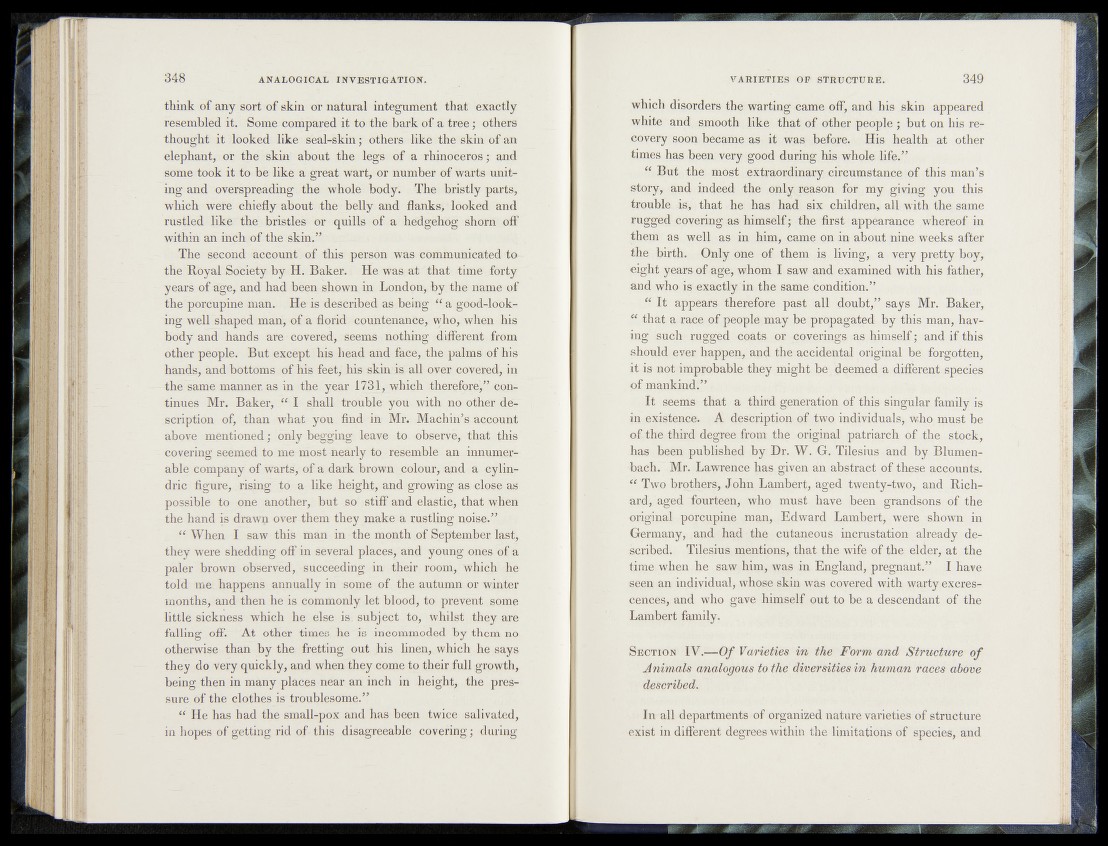
think of any sort of skin or natural integument that exactly
resembled it. Some compared it to the bark o f a tree j others
thought it looked like seal-skin; others like the skin of an
elephant, or the skin about the legs of a rhinoceros; and
some took it to be like a great wart, or number of warts uniting
and overspreading, the whole body. The bristly parts,
which were chiefly about the'belly and flanks, looked and
rustled like the bristles or quills of a hedgehog sham ofl‘
within an'ihtdt’cCike:-akin'.”
The second account. of this person was communicated to-
the Royal Society by H. Baker. He was. at that time forty
years of age, and had been shown in London, by the name of
the porcupine man. He is described as being “ a good-looking
well shaped man, of a florid countenance, wlio, when his
body and hands are - covered, seems - nothing different from
other people. But except his head and face, th e .palms o f his
hands, and bottoms of his feet/ his skin’is all over covered^ in
the same manner, as in the year 1734, which therefor^” conT
tinues Mr. B a k e r , I shall trouble you with hqmth^rXdte^
scription of, than what you. find in Mr. Machin’saceoJTM
above mentioned; only begging leave to observe, that this
covering seemed to me most nearly to resemblei?an innamer^;
able company of warts, of a dark brown colour, and a e-ylin-
dric figure, . rising to a like height, and growing as close as
possible to one another, but -so stiff and elastic, that .when
the hand is drawp over them they make a rustling noise.” ,* J
u When I saw this man jj> in • the month of September, last,,
they were shedding off in several places, and young ones .of a
paler brown observed, succeeding in their room, "which -he
told me happens annually in some of the autumn or winter
months, and then he is commonly let blood, to prevent some
little sickness which he else is. subject to, whilst they are
falling off. At other times he is incommoded by them no
otherwise than by the fretting out his linen, which he says
they do very quickly, and when they come to their full growth,
being then in many places near an inch in height, the pressure
of the clothes is' troublesome.”
“ He has had the small-pox and has been twice salivated,
in hopes of getting rid off this disagreeable covering; during
which disorders the warting came off, and his skin appeared
white and smooth like that of other people ; but on his recovery
soon became as it was before. His health at other
times has been very good during his whole life.”
“ But the most extraordinary circumstance of this man’s
story, and indeed the only reason for my giving you this
trouble is, that he has had six children, all with the same
rugged covering as himself; the first appearance whereof in
them as well as in him, came on in about nine weeks after
the birth. Only one of them is living, a very pretty boy,
eight years of age, whom I saw and examined with his father,
and who is exactly in the same condition.” .,
“ It appears therefore past all doubt,” says Mr. Baker,
" that a. race of.people may be propagated by this man, hav-
ing4siuchf rugged coats or coverings as himself; and if this
should ever happen, and the accidental original be forgotten,
it is not improbable they might be deemed a different species
of mankind"’ ,
It seems that a third generation of this singular family is
in existence. A description of two individuals, w-ho must be
of. the third degree from the original patriarch of the stock,
has been published by Dr. W. G. Tilesius and by Blumen-
bach. Mr. Lawrence has given an abstract o f these accounts.
“ Two brothers,. John Lambert, aged twenty-two, .and Richard,
aged *fourteen, who must, have, been^grandsons of the
original porcupine man, Edward Lambert, .were shown in
Germany, „apd had the cutaneous incrustation already described.
Tilesius mentions, that the wife of the elder, a t the
time when he saw him, was in England, pregnant.” I have
seen an individual, whose skin whs covered with warty excrescences,
and who gave himself out to be a descendant of the
Lambert family.
S ection IV.-—Of Varieties in the Form and Structure o f
Animals analogous to the diversities in human races above
described.
In all departments of organized nature varieties of structure
exist in different degrees within the limitations of species, and